In the deep southwest corner of Germany, not far from the French/German border is the quiet town of Wolfstein. Located between Frankfurt am Main and Saarbrucken, these days there is little trace of its pre WW2 history where some of the greatest tubas of the early 20th century were made.

Schau mal, da gab es ein Tubabauer.
Oddly enough, Sander is not particularly well known in Germany compared to the USA.
Due to family immigrating to America, Sander had a particular connection to that market. In addition one of the most highly regarded tubists of the early 20th century, August Helleberg, also played a Sander before he switched to Conn, which was noticeable inspired by Sander…

why some makers engrave their names with the tuba on its bell is beyond me…
A bit about Helleberg:
Click to access August%20Helleberg.pdf
One of his former Sander tubas is currently in the Simonetti Collection:
Sander, CC tuba, 4 rotary, c.1900

Helleberg in 1911 with his Conn CC-Tuba
An equally famous tubist and student of Helleberg, Fred Geib, also played Sander tubas.

a spiffy looking Mr. Geib with his Sander CC-Tuba
The factory lasted until the 1940s but the Second World War and the resulting destruction ended the firm.
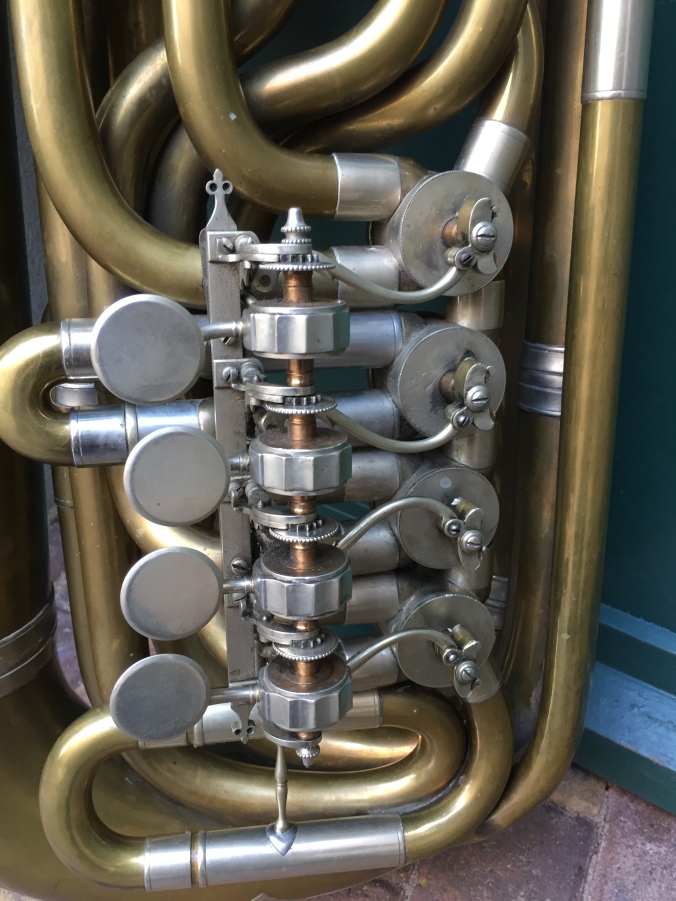
machining this paddle assembly is not for the faint of heart…the american bound instruments tended to have string linkage.
The featured instrument was made sometime in the late 1890s. At some point it found its way into a german symphony orchestra. In the 1930s it received a serious overhaul included replated rotors. Its owner, like so many men, went to war and never came back. His neighbor, who received to the tuba to watch over till he returned, used it as a decoration piece and it stayed there until very recently when a colleague of mine purchased it. His wife likely complained about him having too many tubas and it then came to me.
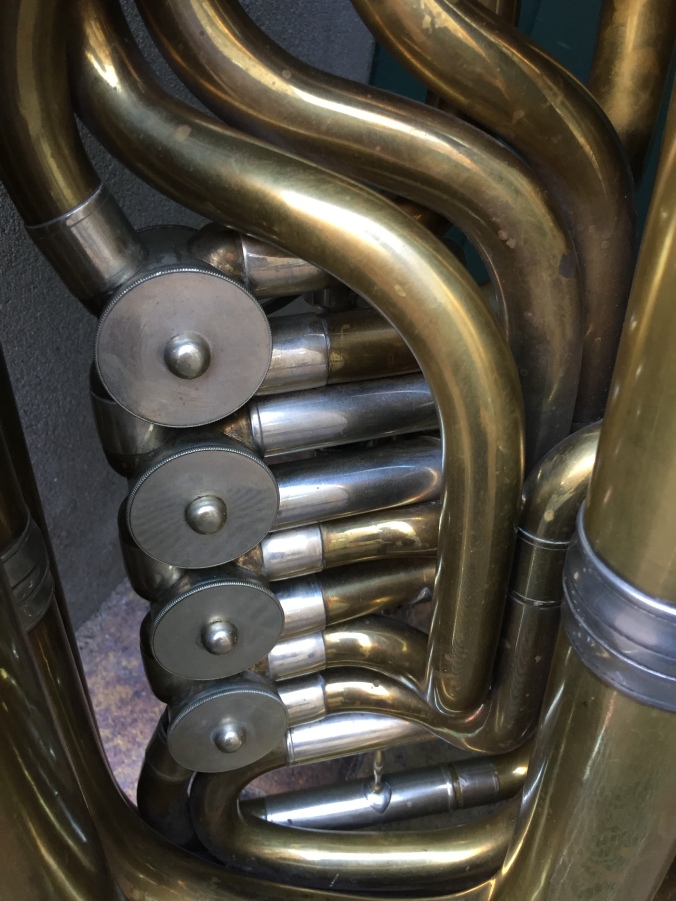
21mm valve tubing
Having searched for just such a tuba for over 20 years, of course I couldn’t say no. My first try was sadly dissapointing, as the tuba had a great sound, but the middle range was badly out of tune and other notes hardly spoke. Initial tests showed the tuba to be air tight and the valves have excellent compression.
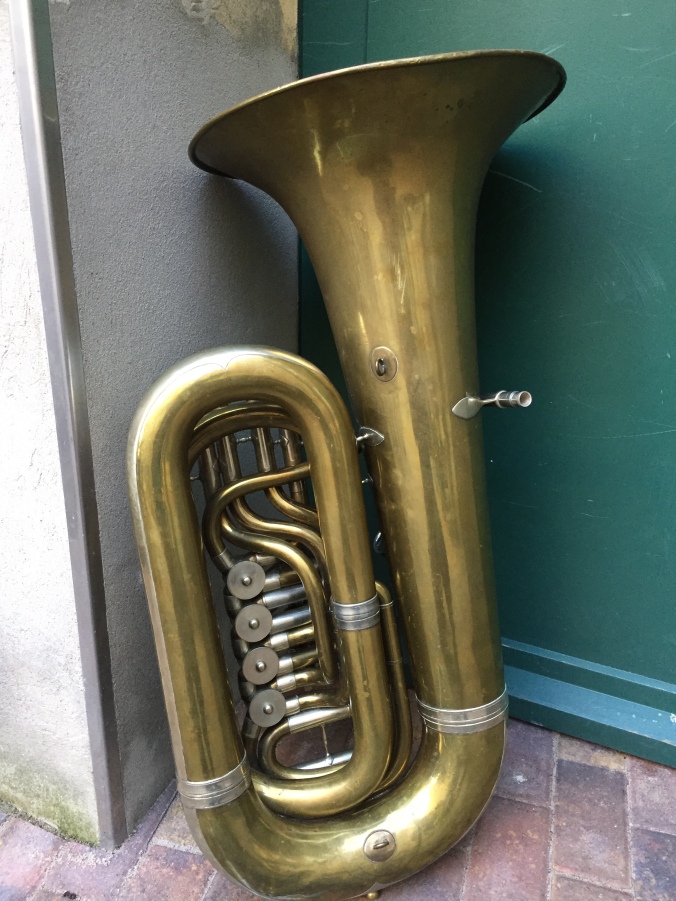
drivers view
I then filled the tuba with water and let it sit for an hour. I then flushed more water through the body under pressure. Slowly but surely something within shifted…audibly and rather unpleasant, sloosh, splat sloosh splat until eventually a large wad of cloth and dirt finally plopped its way out of the bell.

fat seams on these bows
After drying everything out and reoiling the valves, the tuba played astonishingly well. The large bore combined with the fat bows gives a powerful and immediate response. Intonation is every bit as good as a modern tuba. I wouldn’t mind having a 5th valve, but the slides are easy to manipulate and the open blow more than makes up for the lack of a 5th valve.

extra comfy
It quickly becomes obvious why this tuba was sought after by many American tubists in the early 20th century. It provides a big fundamental bass sound yet has the flexibility to play more complicated literature.

not comfy
One can reflect, many famous orchestra pieces were premiered using such tubas. Copland’s Fanfare for the Common Man. Dvorak 9te Symphony, and Bartok’s Concerto for Orchestra. This sound is what the composers had in their ears, what they heard at the premiers.
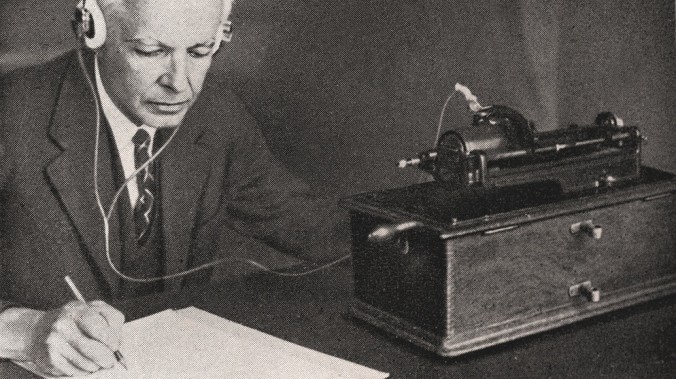
Bartok transcribing Still D.R.E.
In addition to his excellent CC-Tubas, Sander built a number of special tubas, including a few ‘worlds largest tubas’.
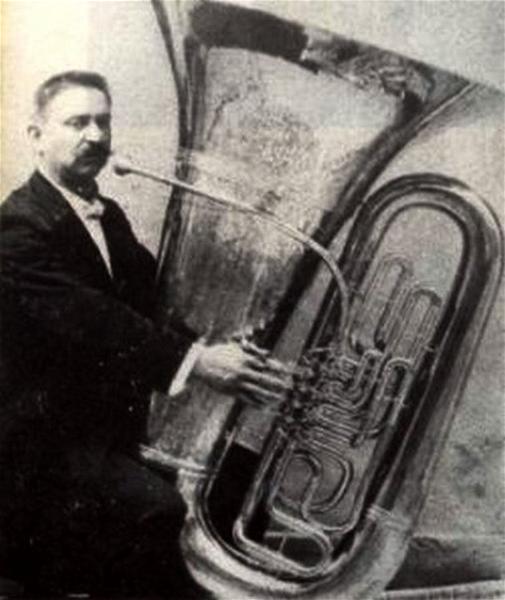
dominance established
There are a few tubas made from pure copper. I tried one many years ago at the Frankfurt Musikmesse and it had a most unusual pure sound. Fred Marzahn had one with a cut bell allowing an upright and front bell.
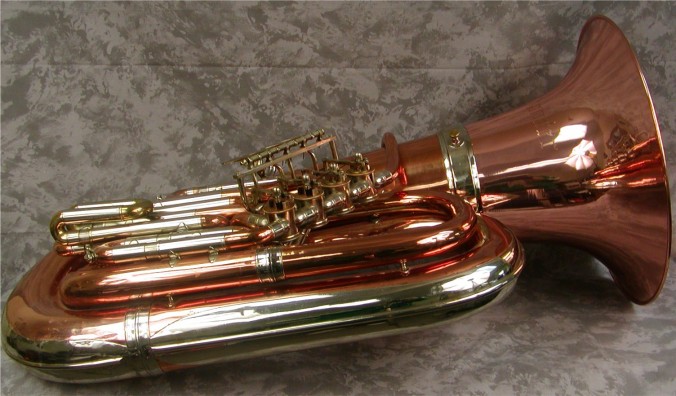
drool….
Gerald Hoffnung, the great british satyrist, commissioned a giant subcontra CCC tuba from Sander, where he used it to great effect.

Gerald and Annetta Hffnung November 13th 1956
Luckily the tuba has survived all these years and it enjoying a quiet life in a private collection

Some bloke;)
Specs: Sander CC-Tuba ca. 1900
Bore: 21mm with 4 rotary valves
Bell Diameter 42cm
Height: 102cm


An excellent article on the Sander tubas; thanks. I hope someday to try one. Incidentally, as you are probably aware, two of August Helleberg’s sons were professional tubists, and they also played the Sander tubas well into mid-century. They were especially active with radio orchestras in New York, and I have seen several photos of them in broadcast studios playing these instruments. People were still talking about the Helleberg family New York tuba “dynasty” when I freelanced there in the 1980s. Keep up the great work.
Thank you Rick!
As a schoolboy in the early 1960s I used to occasionally go to Paxman’s shop in Gerrard Street, London. There was a massive rotary valved tuba half-way down the stairs to the basement. I used to beg for the mouthpiece and try to play the tuba – which was obviously full of dust and with the valves seized up. I think it must have been the Hoffnung Sander tuba.
I don’t know what happened to it – maybe it ended up with Bill Snyder of the Dankworth Orchestra?
Yes it was the same tuba!
Greetings: Following up on our “conversations” regarding the Hellebergs and Sander tubas, I ran across this historic photo of August Helleberg Sr. holding his Conn-made copy of a Sander CC, alongside his two sons each holding an original Sander instrument (presumably also CC). I’ve uploaded it to my website here: https://paragonragtime.com/wp-content/uploads/August-Helleberg-sons-c.1910jpeg.jpg for you to see. This photo was taken on a Sousa Band tour somewhere around 1910. It is from the private collection of my late friend Paul E. Bierley, and appears in his book, “The Incredible Band of John Philip Sousa.” I don’t think that Paul – being a professional tubist himself as well as a generous man – would mind if you reproduced this image if you wished to. Thanks and best wishes from America. Sincerely, Rick Benjamin
Thank you Rick, the photo is absolutely fantastic! All the best, and please stop for a visit if you are ever in Berlin.
Regards,
Louis Kline
Hello! I am also one of the lucky owners of a Sander Tuba from Wolfstein and live only one hour away. Our choir bought it used in the 50s and I have no idea how old it is. It has unfortunately only 3 valves and had to be shortened a few cm to come into nowadays tune (440 Hz). It is tuned in Bb and has a 50cm bell. Would be interested how many of these monsters are still around…. best regards!
Hallo Christian, entschuldigung habe ich Dein Nachricht verpasst! Also falls Du irgendwann nach Berlin kommt, werde ich gerne die alte Sander anschauen.
Viele Grüße aus Berlin,
Louis